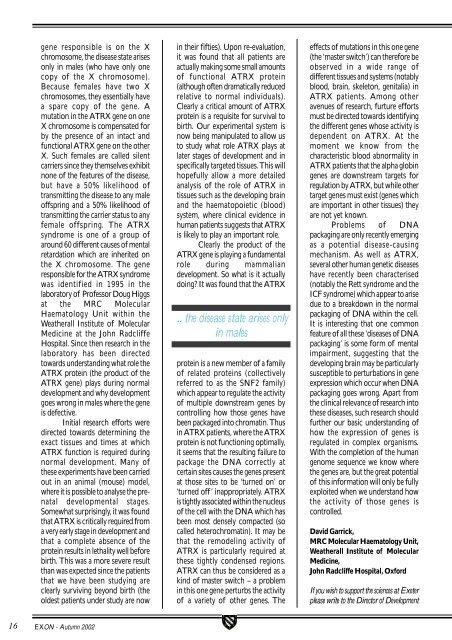2002 - Exeter College - University of Oxford
2002 - Exeter College - University of Oxford
2002 - Exeter College - University of Oxford
You also want an ePaper? Increase the reach of your titles
YUMPU automatically turns print PDFs into web optimized ePapers that Google loves.
gene responsible is on the X<br />
chromosome, the disease state arises<br />
only in males (who have only one<br />
copy <strong>of</strong> the X chromosome).<br />
Because females have two X<br />
chromosomes, they essentially have<br />
a spare copy <strong>of</strong> the gene. A<br />
mutation in the ATRX gene on one<br />
X chromosome is compensated for<br />
by the presence <strong>of</strong> an intact and<br />
functional ATRX gene on the other<br />
X. Such females are called silent<br />
carriers since they themselves exhibit<br />
none <strong>of</strong> the features <strong>of</strong> the disease,<br />
but have a 50% likelihood <strong>of</strong><br />
transmitting the disease to any male<br />
<strong>of</strong>fspring and a 50% likelihood <strong>of</strong><br />
transmitting the carrier status to any<br />
female <strong>of</strong>fspring. The ATRX<br />
syndrome is one <strong>of</strong> a group <strong>of</strong><br />
around 60 different causes <strong>of</strong> mental<br />
retardation which are inherited on<br />
the X chromosome. The gene<br />
responsible for the ATRX syndrome<br />
was identified in 1995 in the<br />
laboratory <strong>of</strong> Pr<strong>of</strong>essor Doug Higgs<br />
at the MRC Molecular<br />
Haematology Unit within the<br />
Weatherall Institute <strong>of</strong> Molecular<br />
Medicine at the John Radcliffe<br />
Hospital. Since then research in the<br />
laboratory has been directed<br />
towards understanding what role the<br />
ATRX protein (the product <strong>of</strong> the<br />
ATRX gene) plays during normal<br />
development and why development<br />
goes wrong in males where the gene<br />
is defective.<br />
Initial research efforts were<br />
directed towards determining the<br />
exact tissues and times at which<br />
ATRX function is required during<br />
normal development. Many <strong>of</strong><br />
these experiments have been carried<br />
out in an animal (mouse) model,<br />
where it is possible to analyse the prenatal<br />
developmental stages.<br />
Somewhat surprisingly, it was found<br />
that ATRX is critically required from<br />
a very early stage in development and<br />
that a complete absence <strong>of</strong> the<br />
protein results in lethality well before<br />
birth. This was a more severe result<br />
than was expected since the patients<br />
that we have been studying are<br />
clearly surviving beyond birth (the<br />
oldest patients under study are now<br />
in their fifties). Upon re-evaluation,<br />
it was found that all patients are<br />
actually making some small amounts<br />
<strong>of</strong> functional ATRX protein<br />
(although <strong>of</strong>ten dramatically reduced<br />
relative to normal individuals).<br />
Clearly a critical amount <strong>of</strong> ATRX<br />
protein is a requisite for survival to<br />
birth. Our experimental system is<br />
now being manipulated to allow us<br />
to study what role ATRX plays at<br />
later stages <strong>of</strong> development and in<br />
specifically targeted tissues. This will<br />
hopefully allow a more detailed<br />
analysis <strong>of</strong> the role <strong>of</strong> ATRX in<br />
tissues such as the developing brain<br />
and the haematopoietic (blood)<br />
system, where clinical evidence in<br />
human patients suggests that ATRX<br />
is likely to play an important role.<br />
Clearly the product <strong>of</strong> the<br />
ATRX gene is playing a fundamental<br />
role during mammalian<br />
development. So what is it actually<br />
doing? It was found that the ATRX<br />
.. the disease state arises only<br />
in males<br />
protein is a new member <strong>of</strong> a family<br />
<strong>of</strong> related proteins (collectively<br />
referred to as the SNF2 family)<br />
which appear to regulate the activity<br />
<strong>of</strong> multiple downstream genes by<br />
controlling how those genes have<br />
been packaged into chromatin. Thus<br />
in ATRX patients, where the ATRX<br />
protein is not functioning optimally,<br />
it seems that the resulting failure to<br />
package the DNA correctly at<br />
certain sites causes the genes present<br />
at those sites to be ‘turned on’ or<br />
‘turned <strong>of</strong>f’ inappropriately. ATRX<br />
is tightly associated within the nucleus<br />
<strong>of</strong> the cell with the DNA which has<br />
been most densely compacted (so<br />
called heterochromatin). It may be<br />
that the remodeling activity <strong>of</strong><br />
ATRX is particularly required at<br />
these tightly condensed regions.<br />
ATRX can thus be considered as a<br />
kind <strong>of</strong> master switch – a problem<br />
in this one gene perturbs the activity<br />
<strong>of</strong> a variety <strong>of</strong> other genes. The<br />
effects <strong>of</strong> mutations in this one gene<br />
(the ‘master switch’) can therefore be<br />
observed in a wide range <strong>of</strong><br />
different tissues and systems (notably<br />
blood, brain, skeleton, genitalia) in<br />
ATRX patients. Among other<br />
avenues <strong>of</strong> research, furture efforts<br />
must be directed towards identifying<br />
the different genes whose activity is<br />
dependent on ATRX. At the<br />
moment we know from the<br />
characteristic blood abnormality in<br />
ATRX patients that the alpha globin<br />
genes are downstream targets for<br />
regulation by ATRX, but while other<br />
target genes must exist (genes which<br />
are important in other tissues) they<br />
are not yet known.<br />
Problems <strong>of</strong> DNA<br />
packaging are only recently emerging<br />
as a potential disease-causing<br />
mechanism. As well as ATRX,<br />
several other human genetic diseases<br />
have recently been characterised<br />
(notably the Rett syndrome and the<br />
ICF syndrome) which appear to arise<br />
due to a breakdown in the normal<br />
packaging <strong>of</strong> DNA within the cell.<br />
It is interesting that one common<br />
feature <strong>of</strong> all these ‘diseases <strong>of</strong> DNA<br />
packaging’ is some form <strong>of</strong> mental<br />
impairment, suggesting that the<br />
developing brain may be particularly<br />
susceptible to perturbations in gene<br />
expression which occur when DNA<br />
packaging goes wrong. Apart from<br />
the clinical relevance <strong>of</strong> research into<br />
these diseases, such research should<br />
further our basic understanding <strong>of</strong><br />
how the expression <strong>of</strong> genes is<br />
regulated in complex organisms.<br />
With the completion <strong>of</strong> the human<br />
genome sequence we know where<br />
the genes are, but the great potential<br />
<strong>of</strong> this information will only be fully<br />
exploited when we understand how<br />
the activity <strong>of</strong> those genes is<br />
controlled.<br />
David Garrick,<br />
MRC Molecular Haematology Unit,<br />
Weatherall Institute <strong>of</strong> Molecular<br />
Medicine,<br />
John Radcliffe Hospital, <strong>Oxford</strong><br />
If you wish to support the sciences at <strong>Exeter</strong><br />
please write to the Director <strong>of</strong> Development<br />
16 EXON - Autumn <strong>2002</strong>

















